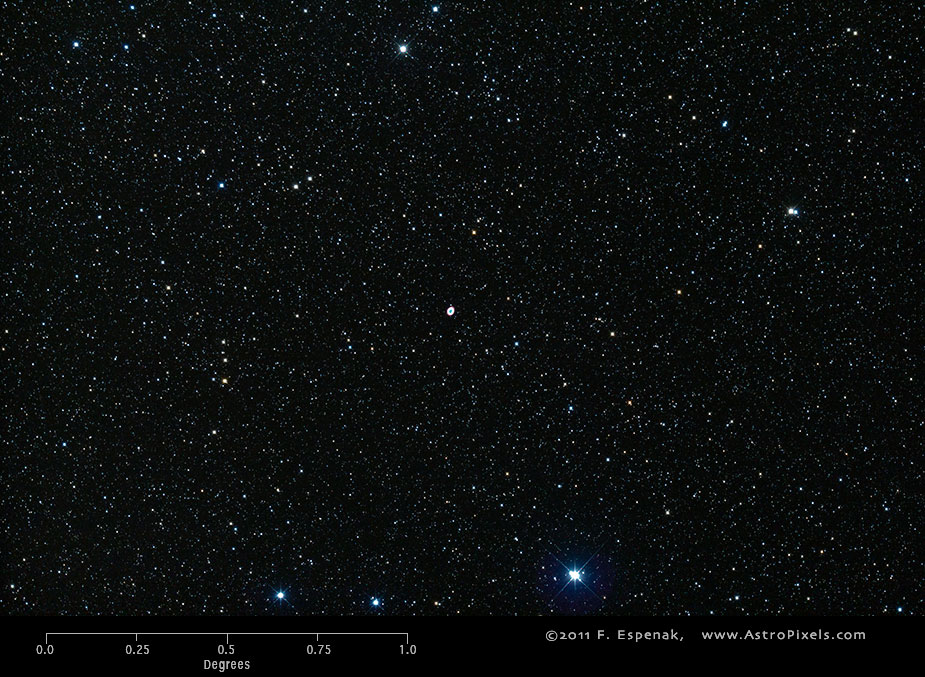
M57 - Ring Nebula
Messier 57 or M57 (also designated NGC 6720) is a planetary nebula in the constellation Lyra. It has an apparent visual magnitude of 8.8 and its angular diameter is 1.4x1.0 arc-minutes. M57 lies at an estimated distance of 2300 light years. The Equinox 2000 coordinates are RA= 18h 53.6m, Dec= +33° 02´ which makes M57 best seen during the summer. The Messier Summer Star Chart shows the position of all Messier objects visible during that season. As one of the more famous objects in the Messier Catalog, it is commonly known as the Ring Nebula.
The image above shows the uncropped view of M57 through the Takahashi E-180 Astrograph (North is to right). A 3x enlargement of this image appears to the right.
M57 was discovered by Darquier in 1779. It is one of only four planetary nebulae in the Messier Catalog (M27, M57, M76, and M97).Recent research shows that the Ring Nebula is actually a torus of ionized gas surrounding its central star, a planet-sized white dwarf with a temperature of over 100,000 K.According to Stoyan et al. (2010), the distance of this planetary nebula is 2300 light years and its diameter is 0.9 light years. However, there is significant uncertainy in these values. Its estimated age is 10,000-20,000 years.
For more information, see the Messier Catalog as well as specific entries for M57 in Wikipedia and SEDS.
Messier's Description of M57
January 31, 1779
`A cluster of light between Gamma and Beta Lyrae, discovered when looking for the Comet of 1779, which has passed it very close: it seems that this patch of light, which is round, must be composed of very small stars: with the best telescopes it is impossible to distinguish them; there stays only a suspicion that they are there. M. Messier reported this patch of light on the Chart of the Comet of 1779. M. Darquier, at Toulouse, discovered it when observing the same comet, and he reports: "Nebula between gamma and beta Lyrae; it is very dull, but perfectly outlined; it is as large as Jupiter and resembles a planet which is fading".'
[this description may have given rise to the term, "Planetary Nebula"]
Technical Details
- Object: M57
- Other Names: NGC 6720, Ring Nebula
- Object Type: planetary nebula
- Object Data: Apparent Magnitude = 8.8, Angular Size = 1.4x1.0 arc-minutes
- Object Position (Equinox 2000): RA= 18h 53.6m, Dec= +33° 02´, Constellation = Lyra
- Date/Time: 2011 Aug 02 at 07:01 UTC
- Location: Bifrost Astronomical Observatory, Portal, AZ
- Mount: Astro-Physics 1200GTO
- Telescope: Takahashi Epsilon 180 Hyperbolic Astrograph
- Camera: Canon EOS 550D (Rebel T2i) (modified with a Baader UV/IR filter)
- Field of View: 1.70° x 2.56° at 1.7 arc-sec/pixel (web version: 10.0 arc-sec/pixel)
- Exposure: 4 x 300s, f/2.8, ISO 800
- File Name: M57-01w.jpg
- Processing (Adobe Camera Raw): Graduated Filter, Vignetting Correction, Noise Reduction, White Balance, Curves
- Processing (Photoshop CS5): Average Images, Curves, Noise Reduction
- Original Image Size: 3454 × 5179 pixels (17.9 MP); 11.5" x 17.3" @ 300 dpi
- Rights: Copyright 2011 by Fred Espenak. All Rights Reserved. See: Image Licensing.
